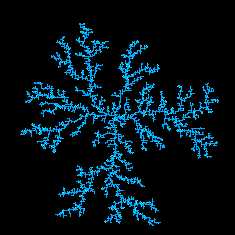标签:
在一次随机化算法测试中我无意发现,通过粒子的随机移动和沉积可构造类似如下图形




首先初始化一个N*N的网格,其中每个格子有几率p1被放置一个粒子,状态设为活跃,在中心放置一个非活跃粒子,
随机选择一个活跃粒子和移动方向(上下左右),若粒子的这个方向上1格没有粒子或边界则移动,若粒子接触到非活跃粒子则有p2几率变为非活跃粒子(沉积),
直到所有粒子变为非活跃状态,算法结束。
通常p1取0.05~0.2,p2取0.5~1.0,也可以对不同的粒子设置不同的p1,p2
加入重力等其它规则有时可以得到意想不到的效果
测试表明此算法在p1=0.1,p2=1时期望时间复杂度大约是O(n4),然而我没有能力证明。
以下是一个简单的实现
#include<cstdio> #include<cstdlib> #include<ctime> const int N=200; const double p1=0.1; const double p2=1.0; int xs[]={-1,0,1,0}; int ys[]={0,-1,0,1}; int bmp[N+2][N+2]; struct pos{ int x,y; pos(){} pos(int a,int b):x(a),y(b){} }ps[N*N]; int p=0; int main(){ srand(time(0)); for(int i=0;i<=N+1;i++)//边界 bmp[0][i]=bmp[N+1][i]=bmp[i][0]=bmp[i][N+1]=-1; for(int i=1;i<=N;i++) for(int j=1;j<=N;j++) if(rand()<RAND_MAX*p1){//初始化 bmp[i][j]=1; ps[p++]=pos(i,j); } bmp[N/2+1][N/2+1]=2; while(p){ int w=rand()%p; int x=ps[w].x,y=ps[w].y; int f=rand()&3; bool d=0; if(bmp[x][y]==2)d=1; else for(int i=0;i<4;i++) if(bmp[x+xs[i]][y+ys[i]]==2) d=1; if(d&&rand()<p2*RAND_MAX){//沉积 bmp[x][y]=2; ps[w]=ps[--p]; continue; } if(bmp[x+xs[f]][y+ys[f]]==0){//移动 bmp[ps[w].x=x+xs[f]][ps[w].y=y+ys[f]]=1; bmp[x][y]=0; } }
//结果保存在数组bmp中 return 0; }
暂时并没有什么实用价值。。
标签:
原文地址:http://www.cnblogs.com/ccz181078/p/5154109.html